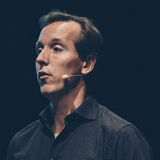Summary
In this talk, Dave Gray uses metaphors like the elephant and the monkey tree to illustrate the complexity of enterprise culture and how perspectives shape what is considered 'obvious' within organizations. Drawing on stories from Lou Gerstner about IBM, Chris Argyris's theories on the ladder of inference and self-sealing logic, and real examples from leaders like Catherine Courage and Chris Ortiz, Dave explains how deeply held beliefs govern behaviors often unnoticed and unchallenged. He highlights how leaders, particularly at the top, live inside self-reinforcing bubbles that can distort reality, and the consequences of unexamined beliefs such as resistance to new ideas or failed initiatives like Kodak's decline. Dave advocates for double loop learning—actively testing beliefs through conversation and experimentation. He shares practical advice for building empathy and safe environments, such as using simple rituals like tea or cookies to foster openness. Finally, Dave stresses switching off autopilot behaviors to engage consciously with moments of change, encouraging attendees to identify needs, beliefs, and behaviors in their organizations and create creditable experiments to accelerate transformational change.
Key Insights
-
•
Organizational 'obvious' is a constructed bubble of shared beliefs reinforced by culture and repeated behaviors.
-
•
People’s beliefs, not just behaviors, need to be understood to achieve genuine buy-in and change.
-
•
Self-sealing logic causes individuals and groups to discount information that contradicts their existing beliefs.
-
•
Leaders face more distorted perceptions due to filtered, sugar-coated information from subordinates—depicted as the monkey tree metaphor.
-
•
Double loop learning and experimentation are essential practices to uncover underlying beliefs and shift organizational culture.
-
•
Small acts of risk-taking, like breaking a dress code or changing routine conversations, can have outsized impacts on organizational dynamics.
-
•
Creating safe spaces through simple gestures (tea, cookies) facilitates vulnerability and honest communication.
-
•
Beliefs form rules for action, driven by underlying human needs such as safety, control, and respect.
-
•
Autopilot behaviors reinforce existing belief bubbles and limit the possibility of meaningful change.
-
•
Effective change requires identifying alternative beliefs and acting as if they are true to test new outcomes.
Notable Quotes
"Whenever you do something with a group of people, you’re creating culture."
"Beliefs are habits of action; they’re rules because we decide how to act based on what we believe."
"You can’t just change your belief by saying I don’t believe that anymore. You have to act as if it were true."
"It’s impossible to be angry with a warm cup of tea in your hand."
"The higher up you are in an organization, the more distorted your reality is likely to be."
"No one is able to fool yourself about your own logic and rationality more than you do."
"Most enterprises are not emotionally safe places; people cannot leave their emotions at the door."
"Small risks can make huge difference. Breaking the dress code is a tiny crack in the autopilot armor."
"If you want to get buy-in, you have to understand the beliefs that motivate behavior."
"Change is only possible in the present moment; autopilot limits that change."
Or choose a question:
















More Videos

"If designers spend more time talking about titles than their work, we’re just gazing into our navels."
Adam Cutler Karen Pascoe Ian Swinson Susan WorthmanDiscussion
June 8, 2016

"Knowing your subject matter as a UX leader is just as important as knowing your craft."
Peter MerholzThe Trials and Tribulations of Directors of UX (Videoconference)
July 13, 2023

"If you don’t tune it properly, sometimes you just don’t get what you want."
Lisa WelchmanCleaning Up Our Mess: Digital Governance for Designers
June 14, 2018

"Sustainable practices are not just a luxury; they are a necessity for our survival."
Vincent BrathwaiteOpener: Past, Present, and Future—Closing the Racial Divide in Design Teams
October 22, 2020

"Growth and learning is your long term change management plan."
Brenna FallonLearning Over Outcomes
October 24, 2019

"Never be afraid to get into good trouble; start by asking why."
Tricia WangSpatial Collapse: Designing for Emergent Culture
January 8, 2024

"Diverging and converging around the business model canvas helped us test and prototype delivery methods for the value propositions."
Edgar Anzaldua MorenoUsing Research to Determine Unique Value Proposition
March 11, 2021
"We manage the environment in which knowledge distribution takes place, not the process itself."
Designing Systems at Scale
November 7, 2018

"Conversion design means to create intentional change."
Erin WeigelGet Your Whole Team Testing to Design for Impact
July 24, 2024
Latest Books All books
Dig deeper with the Rosenbot
How can research ops processes be designed to encourage community contribution and behavior change?
How might subscription services be redesigned using thinking styles to better address user financial and emotional concerns?
What role should AI play in accelerating research synthesis without replacing human judgment?
















